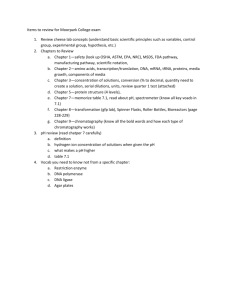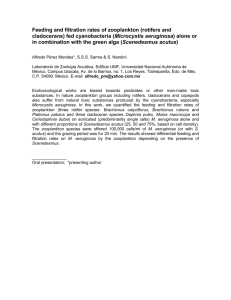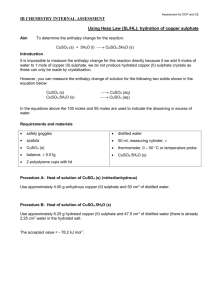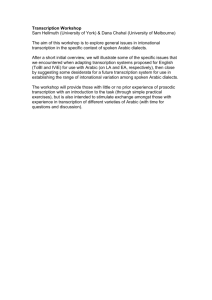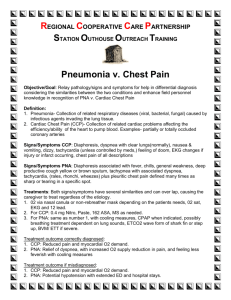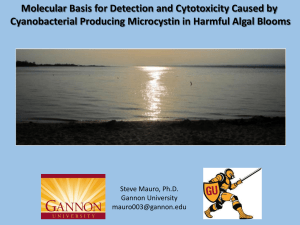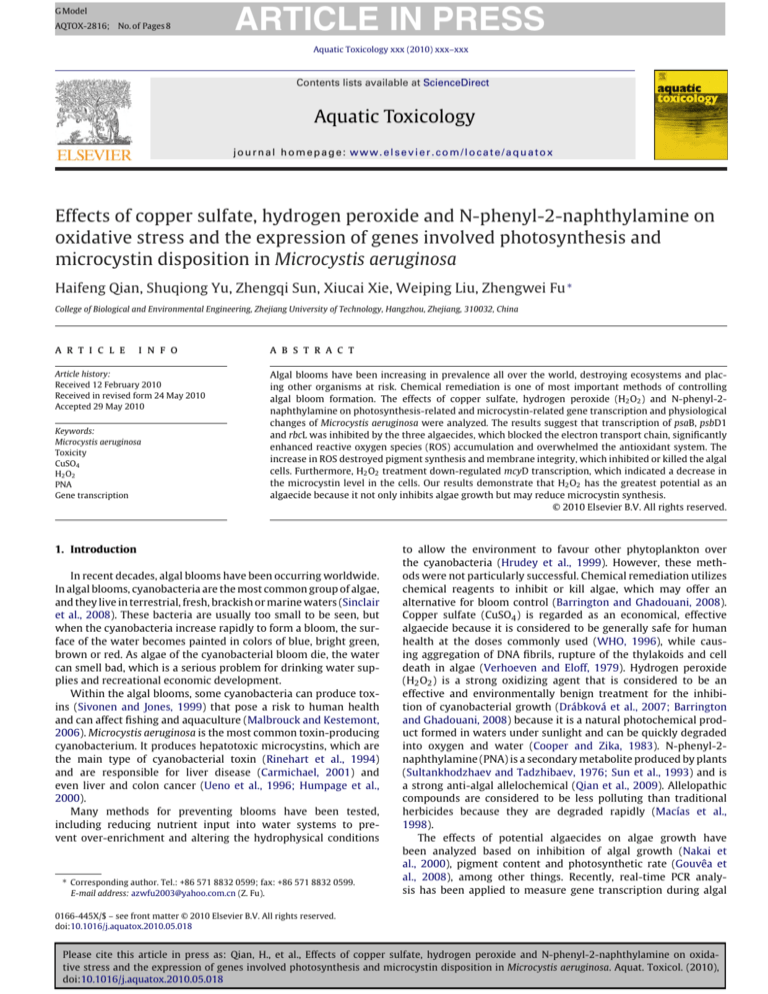
G Model
AQTOX-2816;
No. of Pages 8
ARTICLE IN PRESS
Aquatic Toxicology xxx (2010) xxx–xxx
Contents lists available at ScienceDirect
Aquatic Toxicology
journal homepage: www.elsevier.com/locate/aquatox
Effects of copper sulfate, hydrogen peroxide and N-phenyl-2-naphthylamine on
oxidative stress and the expression of genes involved photosynthesis and
microcystin disposition in Microcystis aeruginosa
Haifeng Qian, Shuqiong Yu, Zhengqi Sun, Xiucai Xie, Weiping Liu, Zhengwei Fu ∗
College of Biological and Environmental Engineering, Zhejiang University of Technology, Hangzhou, Zhejiang, 310032, China
a r t i c l e
i n f o
Article history:
Received 12 February 2010
Received in revised form 24 May 2010
Accepted 29 May 2010
Keywords:
Microcystis aeruginosa
Toxicity
CuSO4
H2 O2
PNA
Gene transcription
a b s t r a c t
Algal blooms have been increasing in prevalence all over the world, destroying ecosystems and placing other organisms at risk. Chemical remediation is one of most important methods of controlling
algal bloom formation. The effects of copper sulfate, hydrogen peroxide (H2 O2 ) and N-phenyl-2naphthylamine on photosynthesis-related and microcystin-related gene transcription and physiological
changes of Microcystis aeruginosa were analyzed. The results suggest that transcription of psaB, psbD1
and rbcL was inhibited by the three algaecides, which blocked the electron transport chain, significantly
enhanced reactive oxygen species (ROS) accumulation and overwhelmed the antioxidant system. The
increase in ROS destroyed pigment synthesis and membrane integrity, which inhibited or killed the algal
cells. Furthermore, H2 O2 treatment down-regulated mcyD transcription, which indicated a decrease in
the microcystin level in the cells. Our results demonstrate that H2 O2 has the greatest potential as an
algaecide because it not only inhibits algae growth but may reduce microcystin synthesis.
© 2010 Elsevier B.V. All rights reserved.
1. Introduction
In recent decades, algal blooms have been occurring worldwide.
In algal blooms, cyanobacteria are the most common group of algae,
and they live in terrestrial, fresh, brackish or marine waters (Sinclair
et al., 2008). These bacteria are usually too small to be seen, but
when the cyanobacteria increase rapidly to form a bloom, the surface of the water becomes painted in colors of blue, bright green,
brown or red. As algae of the cyanobacterial bloom die, the water
can smell bad, which is a serious problem for drinking water supplies and recreational economic development.
Within the algal blooms, some cyanobacteria can produce toxins (Sivonen and Jones, 1999) that pose a risk to human health
and can affect fishing and aquaculture (Malbrouck and Kestemont,
2006). Microcystis aeruginosa is the most common toxin-producing
cyanobacterium. It produces hepatotoxic microcystins, which are
the main type of cyanobacterial toxin (Rinehart et al., 1994)
and are responsible for liver disease (Carmichael, 2001) and
even liver and colon cancer (Ueno et al., 1996; Humpage et al.,
2000).
Many methods for preventing blooms have been tested,
including reducing nutrient input into water systems to prevent over-enrichment and altering the hydrophysical conditions
∗ Corresponding author. Tel.: +86 571 8832 0599; fax: +86 571 8832 0599.
E-mail address: azwfu2003@yahoo.com.cn (Z. Fu).
to allow the environment to favour other phytoplankton over
the cyanobacteria (Hrudey et al., 1999). However, these methods were not particularly successful. Chemical remediation utilizes
chemical reagents to inhibit or kill algae, which may offer an
alternative for bloom control (Barrington and Ghadouani, 2008).
Copper sulfate (CuSO4 ) is regarded as an economical, effective
algaecide because it is considered to be generally safe for human
health at the doses commonly used (WHO, 1996), while causing aggregation of DNA fibrils, rupture of the thylakoids and cell
death in algae (Verhoeven and Eloff, 1979). Hydrogen peroxide
(H2 O2 ) is a strong oxidizing agent that is considered to be an
effective and environmentally benign treatment for the inhibition of cyanobacterial growth (Drábková et al., 2007; Barrington
and Ghadouani, 2008) because it is a natural photochemical product formed in waters under sunlight and can be quickly degraded
into oxygen and water (Cooper and Zika, 1983). N-phenyl-2naphthylamine (PNA) is a secondary metabolite produced by plants
(Sultankhodzhaev and Tadzhibaev, 1976; Sun et al., 1993) and is
a strong anti-algal allelochemical (Qian et al., 2009). Allelopathic
compounds are considered to be less polluting than traditional
herbicides because they are degraded rapidly (Macías et al.,
1998).
The effects of potential algaecides on algae growth have
been analyzed based on inhibition of algal growth (Nakai et
al., 2000), pigment content and photosynthetic rate (Gouvêa et
al., 2008), among other things. Recently, real-time PCR analysis has been applied to measure gene transcription during algal
0166-445X/$ – see front matter © 2010 Elsevier B.V. All rights reserved.
doi:10.1016/j.aquatox.2010.05.018
Please cite this article in press as: Qian, H., et al., Effects of copper sulfate, hydrogen peroxide and N-phenyl-2-naphthylamine on oxidative stress and the expression of genes involved photosynthesis and microcystin disposition in Microcystis aeruginosa. Aquat. Toxicol. (2010),
doi:10.1016/j.aquatox.2010.05.018
G Model
AQTOX-2816;
No. of Pages 8
ARTICLE IN PRESS
2
H. Qian et al. / Aquatic Toxicology xxx (2010) xxx–xxx
growth in Chlorella vulgaris (Qian et al., 2008a) and Thermosynechococcus elongatus (Kós et al., 2008). Photosynthesis is the
principal mode of energy metabolism of algae. In this process, light
energy is captured and used to synthesize sugar while generating
oxygen and consuming carbon dioxide. Therefore, photosynthesis is an indispensable metabolic process. For this reason, we
focused on photosynthesis-related gene transcription to analyze
the effects of the three potential algaecides (CuSO4 , H2 O2 and
PNA) on photosynthesis of M. aeruginosa. These photosynthesisrelated genes included (1) rbcL, which encodes the large subunit
of ribulose-1,5-bisphosphate carboxylase oxygenase (Rubisco) in
alga, (2) psbD1, which encodes the D2 protein that forms the
reaction center of photosystem II (PSII), and (3) psaB, which
encodes one of the reaction center subunits of photosystem I (PS
I).
Since cyanotoxins are one of the main pollutants in algal blooms,
changing the microcystin content has also been considered as a
method to inhibit algal growth. Microcystins are synthesized in
a mixed polyketide synthase/non-ribosomal peptide synthetase
system called microcystin synthetase. Microcystin synthetase is
encoded in two transcribed operons in M. aeruginosa, mcyA-C and
mcyD-J (Tillett et al., 2000). mcyA belongs to the mcyA-C gene
cluster and encodes microcystin synthetase; mcyD belongs to the
mcyD-J gene cluster, and it encodes the modular polyketide synthase involved in the synthesis of the -amino acid Adda that is
responsible for the toxicity of the microcystins (Tillett et al., 2000).
Moreover, mcyD expression is also essential for microcystin synthesis (Christiansen et al., 2006). mcyH is located upstream of mcyE,
and bioinformatic and experimental data have shown that mcyH
is an ABC transporter responsible for microcystin transport, and
that it is intimately associated with the microcystin biosynthesis
pathway (Pearson et al., 2004). For these reasons, we compared the
inhibitory effect of three algaecides on the transcriptional levels
of mcyA, mcyD and mcyH to select the best microcystin inhibitory
agent.
In this study, we also investigated parameters to confirm
the toxicological effects of the three potential algaecides at the
physiological level, such as the activities of three antioxidant
enzymes [superoxide dismutase (SOD), peroxidase (POD) and catalase (CAT)], the oxidant index [malondialdehyde (MDA) content]
and chlorophyll content. The purpose of this research was to characterize the physiological and molecular effects of these three kind
potential algaecides on M. aeruginosa growth, and to select the
most valuable algaecide for controlling algal bloom formation and
potential for microcystin synthesis.
2. Materials and methods
2.1. Algae strains and culture conditions
M. aeruginosa was obtained from the Institute of Hydrobiology
of the Chinese Academy of Sciences (Code: 905) and grown in BG-11
medium as batch cultures in 250 mL flasks. The cultures were maintained under cool-white fluorescent lights (4000 lx) with a daily
cycle of 14 h of light and 10 h of dark. The cell density of culture was
monitored spectrophotometrically at 685 nm (OD685 ). The regression equation between the density of algal cells (Y × 105 /mL) and
OD685 (X) was established as Y = 34.11X + 0.73 (R2 = 0.99). Different concentrations of copper sulfate (CuSO4 , reagent grade, 99.0%
purity; ZhengXin Chemical Co., China), hydrogen peroxide (product
number 31642, Sigma) and N-phenyl-2-naphthylamine (product
number 178055, Aldrich) in the culture medium were prepared.
The relationship between the inhibitor concentration and algal cell
growth rate was evaluated during acute toxicity (from 1 to 4 d) for
M. aeruginosa (Fig. 1).
Fig. 1. Growth of M. aeruginosa cultured in different concentrations of and periods
of exposure to (A) CuSO4 , (B) H2 O2 and (C) PNA.
2.2. RNA extraction, reverse transcription and real-time analysis
Thirty milliliters of culture was centrifuged at 7000 g for 10 min
at 4 ◦ C. Cell pellets were frozen at −80 ◦ C until RNA extraction. Total
RNA was extracted using the RNAiso kit (TaKaRa Company, Dalian,
China) following the manufacturer’s instructions. For reverse transcription, 500 ng of total RNA was mixed with random primers and
reverse transcriptase according to the instructions of the reverse
transcriptase kit (Toyobo, Tokyo, Japan). Real-time PCR was carried
out using an Eppendorf MasterCycler® ep RealPlex4 (WesselingBerzdorf, Germany). Primer pairs for psaB, psbD1, rbcL, mcyA, mcyD
and mcyH are listed in Table 1. The following PCR protocol was
used with two steps: one denaturation step at 95 ◦ C for 1 min and
40 cycles of 95 ◦ C for 15 s, followed by 60 ◦ C for 1 min. 16S rRNA was
used as a housekeeping gene to normalize the expression changes.
The relative gene expression among the treatment groups was
quantified by the 2−Ct method (Livak and Schmittgen, 2001).
2.3. Pigment and enzyme assays
Ten milliliters of each culture was collected and the cell pellet
was resuspended in 1 mL of 0.5 mM K-phosphate (pH 7.0). Phycocyanobilin (PC), allophycocyanin (APC) and phycoerythrin (PE)
were extracted by −80 ◦ C freezing and thawing and absorbance at
565, 620 and 650 nm, respectively, was measured in order to estimate the phycobiliprotein contents according to a previous report
(Li et al., 2008). Thirty milliliters of each culture was were collected for extracting enzyme, the activities of antioxidant enzymes
such as superoxide dismutase (SOD), catalase (CAT) and peroxidase
(POD) were measured by microplate Reader according to our previous report (Qian et al., 2008a). The activity of each enzyme was
expressed on a protein concentration basis.
2.4. Oxidant evaluations
Thirty milliliters of each culture was collected for extracting
product of lipid peroxidation. The lipid peroxidation level was
determined from the MDA content according to Zhang and Kirkham
(1994). ROS were measured using the DCFH-DA probe following the
instructions of the ROS kit (Beyotime Institute of Biotechnology,
Haimen, China). DCFH-DA reacts with ROS to form the fluorescent
Please cite this article in press as: Qian, H., et al., Effects of copper sulfate, hydrogen peroxide and N-phenyl-2-naphthylamine on oxidative stress and the expression of genes involved photosynthesis and microcystin disposition in Microcystis aeruginosa. Aquat. Toxicol. (2010),
doi:10.1016/j.aquatox.2010.05.018
G Model
AQTOX-2816;
No. of Pages 8
ARTICLE IN PRESS
H. Qian et al. / Aquatic Toxicology xxx (2010) xxx–xxx
3
Table 1
Sequences of the primer pairs in Microcystis aeruginosa for real-time PCR.
16S rRNA
psaB
psbD1
rbcL
mcyD
mcyA
mcyH
Forward 5 -GCCGCRAGGTGAAAMCTAA-3
Reverse 5 -AATCCAAARACCTTCCTCCC-3
Forward 5 -CGGTGACTGGGGTGTGTATG-3
Reverse 5 -ACTCGGTTTGGGGATGGA-3
Forward 5 -TCTTCGGCATCGCTTTCTC-3
Reverse 5 -CACCCACAGCACTCATCCA-3
Forward 5 -CGTTTCCCCGTCGCTTT-3
Reverse 5 -CCGAGTTTGGGTTTGATGGT-3
Forward 5 -GGTTCGCCTGGTCAAAGTAA-3
Reverse 5 -CCTCGCTAAAGAAGGGTTGA-3
Forward 5 -GCCGATGTTTGGCTGTAAAT-3
Reverse 5 -ATCCAGCAGTTGAGCAAGC-3
Forward 5 -GGAATGCAGGAACTGGTTGTTT-3
Reverse 5 -GTCATTTCACGGGTTGTTTTAGG-3
product DCF, which is measured with a fluorescence plate reader
(Bio-TEK, USA). An increase in fluorescence intensity indicates the
content of ROS.
2.5. Data analysis
All Data are presented as mean ± standard error of the mean
(SEM) and tested for statistical significance by analysis of variance
(ANOVA) followed by the Dunnett’s post hoc test using StatView
5.0 program. When the probability (p) was less than 0.05 or 0.01,
the values were considered significantly different.
3. Results
3.1. Effects of CuSO4 , H2 O2 and PNA on M. aeruginosa growth
Culture media containing five concentrations of CuSO4 (0, 0.1,
0.5, 1 and 1.5 M) and H2 O2 (0, 10, 25, 50 and 100 M) and four
concentrations of PNA (0, 0.1, 0.5 and 1 mg L−1 ) were prepared to
evaluate their ability to inhibit growth of M. aeruginosa. The growth
of M. aeruginosa was significantly inhibited during 6–96 h of exposure to CuSO4 (Fig. 1). The percent inhibition showed dose- and
time-dependent behaviors. The highest percent inhibition achieved
was 60.8% after 96 h of exposure to 1.5 M CuSO4 . We selected 0.1
and 0.5 M CuSO4 concentrations for subsequent exposure experiments. H2 O2 inhibited algae growth in a dose-dependent manner,
and the highest percent inhibition was 93.4% after 72 h of exposure
to 100 M H2 O2 . Algal growth recovered significantly after 96 h of
H2 O2 exposure, which indicated that H2 O2 was readily degraded in
the water system. We selected 25 and 50 M H2 O2 concentrations
for subsequent exposure experiments. PNA also inhibited algal
growth significantly in time- and dose-dependent manners similarly to CuSO4 . The highest percent inhibition was 65.3%, which was
observed after 96 h of exposure to 1 mg L−1 PNA. We selected 0.5
and 1 mg L−1 PNA concentrations for subsequent exposure experiments.
3.2. Effects of CuSO4 , H2 O2 and PNA on transcription of
photosynthesis-related genes
The level of psaB was significantly reduced by treatment with
CuSO4 in a dose-dependent manner; 54.2% and 50.5% of the control at 0.1 M and 11.2% and 42.1% of the control at 0.5 M were
observed after 48 and 96 h of exposure, respectively (Fig. 2A). Treatment with 25 M H2 O2 did not influence the transcription of psaB
significantly; however, 50 M H2 O2 decreased the transcription of
psaB to 29.3% and 24.0% of the control after 48 and 96 h of exposure,
respectively (Fig. 2B). The effect of PNA on the transcription of psaB
was quite different compared to both CuSO4 and H2 O2 exposure.
The transcription of psaB was significantly lower after 48 h of PNA
exposure but returned to the control level after 96 h of exposure
(Fig. 2C).
140–369
U03402
348–460
GeneID: 5865589
109–189
GeneID: 5864945
762–889
GeneID: 5865621
10,960–11,257
GeneID: 5864684
6149–6338
GeneID: 5864681
1262–1391
GeneID: 5864688
The transcription of psbD1 decreased after CuSO4 exposure, and
the lowest level of psbD1 transcription was only 14.0% of the control
after 48 h of exposure to 0.1 M CuSO4 (Fig. 2D). psbD1 transcription was not affected significantly after 48 h of exposure to H2 O2 ,
but it decreased to 46.7% after exposure to 50 M H2 O2 for 96 h
(Fig. 2E). The effect of PNA on psbD1 transcription showed a similar
pattern to H2 O2 exposure. After 96 h of exposure to 0.5 and 1 mg L−1
PNA, the abundance of psbD1 decreased to 51.4% and 49.1% of the
control, respectively (Fig. 2F).
The transcription of rbcL was inhibited significantly by these
three algaecides (Fig. 2G–I). The lowest rbcL abundance was 17.1%
of the control after 48 h of exposure to 0.5 M CuSO4 . The lowest rbcL abundance after H2 O2 treatment was 38.9% of the control,
which was observed after 48 h of exposure to 50 M H2 O2 . The
lowest rbcL abundance after PNA treatment was 21.0% of the control, which was observed after 96 h of exposure to 1 mg L−1 PNA. In
Fig. 2G–I, the results also show dose-dependent inhibition of rbcL
transcription. The higher the concentration of inhibitor used, the
stronger was the inhibition of rbcL transcription.
3.3. Effects of CuSO4 , H2 O2 and PNA on transcription of
microcystin-related genes
The three algaecides also greatly affected the transcription of
toxin-related genes. Fig. 3A shows that 0.5 M CuSO4 stimulated
the transcription of mcyA by 2.1-fold compared to the control after
48 h of exposure, but it did not affect its transcription after 96 h
of exposure. H2 O2 at 50 M also stimulated mcyA transcription by
1.8-fold after 48 h of treatment, but it did not significantly influence
transcription after 96 h of exposure (Fig. 3B). PNA did not change
the transcription of mcyA after 48 h of treatment, but 1 mg L−1 PNA
stimulated mcyA transcription by 3.6-fold after 96 h of exposure
(Fig. 3C).
The transcription of mcyD was not affected by 0.1 or 0.5 M
CuSO4 treatment after 48 h, but levels decreased to 59.8% and 46.5%
of the control after 96 h of exposure, respectively (Fig. 3D). The
pattern of H2 O2 inhibition of mcyD transcription was similar to
the pattern of CuSO4 . After 96 h of exposure, mcyD transcription
decreased to 47.1% of the control with 50 M H2 O2 (Fig. 3E). PNA
did not have a significant effect on mcyD transcription (Fig. 3F).
Fig. 3G–I shows that mcyH transcription was not stimulated or
inhibited by the three algaecides at the two time points analyzed,
except for a decrease in expression after 96 h of exposure to 50 M
H2 O2 .
3.4. Effects of CuSO4 , H2 O2 and PNA on antioxidant enzymes
To determine whether these three algaecides affect the antioxidant system, we examined the activities of antioxidant enzymes
(Fig. 4A–I). SOD activity increased to 6.1- and 2.6-fold of the con-
Please cite this article in press as: Qian, H., et al., Effects of copper sulfate, hydrogen peroxide and N-phenyl-2-naphthylamine on oxidative stress and the expression of genes involved photosynthesis and microcystin disposition in Microcystis aeruginosa. Aquat. Toxicol. (2010),
doi:10.1016/j.aquatox.2010.05.018
G Model
AQTOX-2816;
4
No. of Pages 8
ARTICLE IN PRESS
H. Qian et al. / Aquatic Toxicology xxx (2010) xxx–xxx
Fig. 2. Expression of psaB (A–C), psbD1 (D–F) and rbcL (G–I) in M. aeruginosa exposed to different concentrations of CuSO4 , H2 O2 and PNA for 48 and 96 h. Values were
normalized to levels of 16S rRNA, a housekeeping gene, and represent the mean mRNA expression value ± S.E.M. (n = 3) relative to the control. * represents a statistically
significant difference of p < 0.05 when compared to the control, ** represents a statistically significant difference of p < 0.01.
trol after 48 and 96 h of exposure to 0.5 M CuSO4 , respectively
(Fig. 4A). Higher concentrations of H2 O2 also stimulated SOD activity, which increased to 3.6- and 1.4-fold of the control after 48 and
96 h of exposure (Fig. 4B). The two concentrations of PNA did not
affect the activity of SOD significantly (Fig. 4C). Fig. 4D–F shows that
the three algaecides induced significant increases in POD activity.
CuSO4 at 0.5 M stimulated the activity of POD by 2.8-fold compared to the control after 48 h of exposure. H2 O2 treatment also
increased POD activity, and the highest POD activity observed was
1.6-fold of the control after 48 h of exposure to 25 M H2 O2 . PNA
did not increase POD activity after 48 h of treatment; however, the
two concentrations of PNA stimulated POD activity to more than 5fold of the control after 96 h of exposure. As shown in Fig. 4G–I, the
three algaecides stimulated the activity of CAT to different degrees.
The higher concentration of CuSO4 stimulated CAT activity by 4.3and 2.7-fold of the control after 48 and 96 h of exposure, respectively. H2 O2 and PNA also showed similar effects on CAT activity as
shown in Fig. 4G and I.
3.5. Effects of CuSO4 , H2 O2 and PNA on pigment, MDA and ROS
levels
Chlorophyll a (Chl a) and phycobiliproteins, including PE, PC and
APC, are the primary light-harvesting chromoproteins in cyanobacteria and have an important role in algal photosynthesis. Chl a
content decreased after exposure to the algaecides in a dosedependent manner. The lowest level of Chl a was only 7.3% of the
control after 96 h of exposure to 0.5 M CuSO4 (Fig. 5). The synthesis of phycobiliproteins was also inhibited by the three algaecides.
The lowest levels of PE, PC and APC were 10.2%, 7.0% and 7.0% of
the control, respectively (Fig. 6).
MDA, a by-product of lipid peroxidation, was quantified to
ascertain the involvement of lipid peroxidation in the toxicity of
these algaecides. Treatment with each algaecide had similar effects
on MDA. After 0.5 M CuSO4 treatment, the MDA concentration
was more than 4- and 5-fold higher than the control after 48 and
96 h of exposure (Table 2). H2 O2 at 25 M caused a nearly 2-fold
increase in the MDA concentration relative to the control (Table 2).
The highest level of MDA was 3.9-fold of the control after 96 h of
exposure to 1 mg L−1 PNA.
ROS production was assessed quantitatively by fluorescence
intensity. ROS production resembled an oxidative burst after exposure to 0.5 M CuSO4 (Fig. 7) and accumulated to levels 2.1- and
2.5-fold that of the control after 48 and 96 h of exposure, respectively. The change in ROS production induced by H2 O2 was similar
to CuSO4 exposure. The two selected concentrations of H2 O2 stimulated ROS production in a dose-dependent manner. The highest
level of ROS production was 1.4-fold of the control after 48 h of
exposure to 50 M H2 O2 . The highest concentration of PNA also
stimulated ROS formation significantly.
Please cite this article in press as: Qian, H., et al., Effects of copper sulfate, hydrogen peroxide and N-phenyl-2-naphthylamine on oxidative stress and the expression of genes involved photosynthesis and microcystin disposition in Microcystis aeruginosa. Aquat. Toxicol. (2010),
doi:10.1016/j.aquatox.2010.05.018
G Model
AQTOX-2816;
No. of Pages 8
ARTICLE IN PRESS
H. Qian et al. / Aquatic Toxicology xxx (2010) xxx–xxx
5
Fig. 3. Expression of mcyA (A–C), mcyD (D–F) and mcyH (G–I) in M. aeruginosa exposed to different concentrations of CuSO4 , H2 O2 and PNA for 48 and 96 h. Values were
normalized to levels of 16S rRNA, a housekeeping gene, and represent the mean mRNA expression value ± S.E.M. (n = 3) relative to the control. * represents a statistically
significant difference of p < 0.05 when compared to the control, ** represents a statistically significant difference of p < 0.01.
4. Discussion
There are few reports in the literature on the effects of chemical reagents on M. aeruginosa, and most of them only describe
changes in algal mortality, chlorophyll content, cellular-soluble
protein, photosynthetic activity and other physiological parameters (Drábková et al., 2007; Hong et al., 2008; Pan et al., 2008). In
the present study, we investigated the effect of CuSO4 , H2 O2 and
PNA not only on the above-mentioned physiological parameters
but also on the transcription of photosynthesis- and microcystin synthesis-related genes, psaB, psbD1 and rbcL, which are
Table 2
MDA levels after exposure to CuSO4 , H2 O2 and PNA.
MDA (nmol/g protein)
48 h
96 h
CuSO4
0 M
0.1 M
0.5 M
1.3 ± 0.1
1.4 ± 0.0
5.4 ± 0.5**
1.7 ± 0.1
2.0 ± 0.2
9.7 ± 0.6**
H2 O2
0 M
25 M
50 M
1.6 ± 0.1
1.8 ± 0.1
2.4 ± 0.3**
3.9 ± 0.1
4.3 ± 0.1
8.7 ± 0.7**
PNA
0 mg L−1
0.5 mg L−1
1 mg L−1
2.7 ± 0.1
4.0 ± 0.4
4.2 ± 0.7*
4.0 ± 1.2
9.6 ± 1.5**
15.5 ± 0.4**
*
Represents a statistically significant difference of p < 0.05 when compared to the
control.
**
Represents a statistically significant difference of p < 0.01.
photosynthesis-related genes, encode key proteins in PSI, PSII and
the carbon assimilation process, respectively. The results obtained
in the present study showed that CuSO4 , H2 O2 and PNA inhibited psaB and psbD1 transcription after 48 or 96 h of exposure.
The decrease in photosynthesis-related gene transcription could
block electron transport and decrease reducing equivalent production, which are necessary for the process of carbon assimilation.
Therefore, the activity of rubisco, the rate-limiting enzyme in carbon assimilation, must be reduced, which agrees with the observed
decrease in rbcL transcript abundance. We also analyzed the content of the photosynthetic pigments, chl a, PE, PC and APC and
found that photosynthetic pigment levels decreased significantly.
Because these pigments capture the light energy necessary for
photosynthesis, the decrease in their abundance could also block
photosynthesis. This phenomenon of inhibition of photosynthesisrelated genes by algaecides was similar to our previous reports on
C. vulgaris after herbicide exposure (Qian et al., 2008a; Qian et al.,
2008b; Qian et al., 2009). ROS was produced by molecular oxygen
combined with surplus electrons, which may also involved in the
inhibition of the electron transport chain. The increased ROS production led to membrane deterioration, as indicated by the increase
in the MDA level (Table 2).
Microcystins are another research hotspot because they cause
serious health and environmental problems. Microcystin synthesis
is catalyzed by microcystin synthetase, which includes two transcribed operons that encode the microcystin peptide synthetase
and polyketide synthase genes. A few studies have focused specif-
Please cite this article in press as: Qian, H., et al., Effects of copper sulfate, hydrogen peroxide and N-phenyl-2-naphthylamine on oxidative stress and the expression of genes involved photosynthesis and microcystin disposition in Microcystis aeruginosa. Aquat. Toxicol. (2010),
doi:10.1016/j.aquatox.2010.05.018
G Model
AQTOX-2816;
6
No. of Pages 8
ARTICLE IN PRESS
H. Qian et al. / Aquatic Toxicology xxx (2010) xxx–xxx
Fig. 4. Activities of superoxide dismutase (A–C), peroxidase (D–F) and catalase (G–I) in M. aeruginosa exposed to different concentrations of CuSO4 , H2 O2 and PNA for 48
and 96 h. The Y-axis represents the activities of enzymes expressed as the mean ± SEM of three replicate cultures. * represents a statistically significant difference of p < 0.05
when compared to the control, ** represents a statistically significant difference of p < 0.01.
Fig. 5. Inhibitory effects of CuSO4 , H2 O2 and PNA on chlorophyll a content in M.
aeruginosa exposed to different inhibitor concentrations for 48 and 96 h. * represents
a statistically significant difference of p < 0.05 when compared to the control, **
represents a statistically significant difference of p < 0.01.
ically on the microcystin biosynthesis genes and shown the effects
of single or combined factors on microcystin synthesis (Kaebernick
et al., 2000; Sevilla et al., 2008; Shao et al., 2009). However, some
of these results have been contradictory. In this study, we selected
mcyA and mcyD as representatives of microcystin synthetase and
used real-time PCR to analyze the transcript levels of these genes.
The results showed that the abundance of mcyA was increased by
CuSO4 , H2 O2 and PNA exposure to different degrees, which may
indiate an increase in microcystin peptide synthetase. In a previous report, only the mcyA gene was used as a target gene to
quantify microcystin production in cyanobacteria by real-time PCR
(Furukawa et al., 2006). This report showing that CuSO4 , H2 O2 and
PNA stimulated the transcription of the mcyA gene to increase the
activity of microcystin peptide synthetase, which could increase
microcystin production. This result agrees with Shao et al. (2009),
who reported that the transcription of mcyB (which is regulated by
the same operon as mcyA) was up-regulated by pyrogallol, another
allelochemical.
mcyD is involved in synthesis of the -amino acid Adda, which is
responsible for the toxicity of the microcystins (Tillett et al., 2000).
Moreover, mcyD expression is essential for microcystin synthesis,
and lack of the protein results in the absence of microcystin synthesis (Kaebernick et al., 2002; Christiansen et al., 2006). Our results
showed that mcyD transcript abundance was decreased by CuSO4
and H2 O2 . It is particularly interesting that the regulation of mcyD
was different from mcyA, which may ascribe that these two genes
belong to two operons and have bidirectional promoters. Due to
its involvement in the synthesis of the -amino acid Adda, the
Please cite this article in press as: Qian, H., et al., Effects of copper sulfate, hydrogen peroxide and N-phenyl-2-naphthylamine on oxidative stress and the expression of genes involved photosynthesis and microcystin disposition in Microcystis aeruginosa. Aquat. Toxicol. (2010),
doi:10.1016/j.aquatox.2010.05.018
G Model
AQTOX-2816;
No. of Pages 8
ARTICLE IN PRESS
H. Qian et al. / Aquatic Toxicology xxx (2010) xxx–xxx
7
Fig. 6. Inhibitory effects of CuSO4 , H2 O2 and PNA on PE (A–C), PC (D–F) and APC (G–I) levels in M. aeruginosa exposed to different inhibitor concentrations for 48 and 96 h. *
represents a statistically significant difference of p < 0.05 when compared to the control, ** represents a statistically significant difference of p < 0.01.
mcyD protein directly determines the quantity of substrate available for microcystin synthesis. A decrease in mcyD transcription
would block microcystin synthesis even though the amount of the
microcystin peptide synthetase increased due to an increase in
mcyA transcription. These results demonstrated that CuSO4 and
H2 O2 are more suitable algaecide because they may inhibit microcystin synthesis.
5. Conclusion
Fig. 7. Stimulatory effects of CuSO4 , H2 O2 and PNA on ROS content in M. aeruginosa
exposed to different inhibitor concentrations for 48 and 96 h. * represents a statistically significant difference of p < 0.05 when compared to the control, ** represents
a statistically significant difference of p < 0.01.
Studies have demonstrated that the three algaecides inhibit
transcription of photosynthesis-related genes, which may block the
electron transport chain to form ROS. The increased level of ROS
could destroy pigment synthesis and the integrity of membrane,
resulting in algal cell death. However, copper compound is not
biodegradable, and once it is released into the environment, it accumulates in organisms’ bodies or sediments. Therefore, the broad
application of CuSO4 to inhibit harmful algae could result in metal
compound secondary pollution. PNA is an effective new algaecide, but the toxicity of PNA (including its degradation products)
to aquatic organisms, like fish, shellfish or plankton, has not been
widely studied. Many more studies should be conducted before
PNA is applied for algal bloom control. H2 O2 inhibited M. aeruginosa growth by blocking transcription of photosynthesis-related
genes or destroying photosynthetic pigments. More importantly,
H2 O2 was the only reagent of these three potential algaecides
that decreased the transcription of the microcystin transport gene,
which can prevent transport of microcystin into the water system. In view of these merits and its ability to be degraded easily,
H2 O2 has good activity and could potentially be used to control
Please cite this article in press as: Qian, H., et al., Effects of copper sulfate, hydrogen peroxide and N-phenyl-2-naphthylamine on oxidative stress and the expression of genes involved photosynthesis and microcystin disposition in Microcystis aeruginosa. Aquat. Toxicol. (2010),
doi:10.1016/j.aquatox.2010.05.018
G Model
AQTOX-2816;
No. of Pages 8
8
ARTICLE IN PRESS
H. Qian et al. / Aquatic Toxicology xxx (2010) xxx–xxx
algal blooms. However, given easy degradation of H2 O2 and complexity of natural water system, many studies are needed to reveal
the persistence and applicable concentration of H2 O2 under natural
condition before it can be recommended as a common algicide.
Acknowledgements
This work was financially supported by the National Basic
Research Program of China (No. 2010CB126100), the Natural Science Foundation of China (20607020) and the Natural Science
Foundation of Zhejiang Province (Y5080019).
References
Barrington, D.J., Ghadouani, A., 2008. Application of hydrogen peroxide for the
removal of toxic cyanobacteria and other phytoplankton from wastewater. Environ. Sci. Technol. 42, 8916–8921.
Carmichael, W.W., 2001. Health effects of toxin-producing cyanobacteria: “The
CyanoHABs”. Hum. Eco. Risk Assess. 7, 1393–1407.
Christiansen, G., Kurmayer, R., Liu, Q., Börner, T., 2006. Transposons inactivate biosynthesis of the nonribosomal peptide microcystin in naturally occurring Planktothrix spp. Appl. Environ. Microbiol. 72 (1), 117–
123.
Cooper, W.J., Zika, R.G., 1983. Photochemical formation of H2 O2 in surface and
ground waters exposed to sunlight. Science 220 (4598), 711–712.
Drábková, M., Admiraal, W., Marsálek, B., 2007. Combined exposure to hydrogen
peroxide and light–selective effects on cyanobacteria, green algae, and diatoms.
Environ. Sci. Technol. 41, 309–314.
Furukawa, K., Noda, N., Tsuneda, S., Saito, T., Itayama, T., Inamori, Y., 2006. Highly
sensitive real-time PCR assay for quantification of toxic cyanobacteria based on
microcystin synthetase A gene. J. Biosci. Bioeng. 102 (2), 90–96.
Gouvêa, S.P., Boyer, G.L., Twiss, M.R., 2008. Influence of ultraviolet radiation, copper, and zinc on microcystin content in Microcystis aeruginosa (Cyanobacteria).
Harmful Algae 7, 194–205.
Hong, Y., Hu, H.Y., Li, F.M., 2008. Physiological and biochemical effects of allelochemical ethyl 2-methyl acetoacetate (EMA) on cyanobacterium Microcystis
aeruginosa. Ecotoxicol. Environ. Saf. 71, 527–534.
Hrudey, S., Burch, M.D., Drikas, M., Gregory, R., 1999. Remedial measures. In: Chorus, I., Bartram, J. (Eds.), Toxic cyanobacteria in water: a guide to their public
health consequences, monitoring, and management. E & FN Spon, NewYork, pp.
275–312.
Humpage, A.R., Fenech, M., Thomas, P., Falconer, I.R., 2000. Micronucleus induction
and chromosome loss in transformed human white cells indicate clastogenic
and aneugenic action of the cyanobacterial toxin, cylindrospermopsin. Mutat.
Res.-Gen. Toxicol. Environ. 472, 155–161.
Kaebernick, M., Dittmann, E., Borner, T., Neilan, B.A., 2002. Multiple alternate transcripts direct the biosynthesis of microcystin, a cyanobacterial nonribosomal
peptide. Appl. Environ. Microbiol. 68, 449–455.
Kaebernick, M., Neilan, B., Börner, T., Dittmann, E., 2000. Light and the transcriptional
response of the microcystin biosynthesis gene cluster. Appl. Environ. Microbiol.
66, 3387–3392.
Kós, P.B., Deák, Z., Cheregi, O., Vass, I., 2008. Differential regulation of psbA and
psbD gene expression, and the role of the different D1 protein copies in the
cyanobacterium Thermosynechococcus elongatus BP-1. Biochim. Biophys. Acta
1777, 74–83.
Li, X., Pan, H., Xu, J., Xian, Q., Gao, S., Yin, D., Zou, H., 2008. Allelopathic effects of
Ceratophyllum demersum and Microcystis aeruginosa in cocultivation. Acta Sci.
Circumstantiae 28, 2243–2249.
Livak, K.J., Schmittgen, T.D., 2001. Analysis of relative gene expression data using
real-time quantitative PCR and the 2 −Ct method. Methods 25, 402–408.
Macías, F.A., Oliva, R.M., Simonet, A.M., Galindo, J.C.G., 1998. What are allelochemicals? In: Olofsdotter, M. (Ed.), Allelopathy in Rice. IRRI Press, Manilla, pp. 69–79.
Malbrouck, C., Kestemont, P., 2006. Effects of microcystins on fish. Environ. Toxicol.
Chem. 1, 72–86.
Nakai, S., Inoue, Y., Hosomi, M., Murakami, A., 2000. Myriophyllum spicatumreleasing allelopathic polyphenols inhibiting growth blue-green algae Microcystis
aeruginosa. Water Res. 34, 3026–3032.
Pan, X.J., Chan, F.Y., Kang, L.J., Liu, Y.D., Li, G.B., Li, D.H., 2008. Effects of gibberellin A3
on growth and microcystin production in Microcystis aeruginosa (cyanophyta).
J. Plant Physiol. 165, 1691–1697.
Pearson, L.A., Hisbergues, M., Börner, T., Dittmann, E., Neilan, B.A., 2004. Inactivation
of an ABC transporter gene, mcyH, results in loss of microcystin production in
the cyanobacterium Microcystis aeruginosa PCC 7806. Appl. Environ. Microbiol.
70, 6370–6378.
Qian, H.F., Sheng, G.D., Liu, W.P., Lu, Y.C., Liu, Z.H., Fu, Z.W., 2008a. Inhibitory effects of
atrazine on Chlorella vulgaris as assessed by real-time polymerase chain reaction.
Environ. Toxicol. Chem. 27, 182–187.
Qian, H.F., Chen, W., Sheng, G.D., Xu, X.Y., Liu, W.P., Fu, Z.W., 2008b. Effects of glufosinate on antioxidant enzymes, subcellular structure, and gene expression in
the unicellular green alga Chlorella vulgaris. Aquat. Toxicol. 88 (4), 301–307.
Qian, H.F., Xu, X.Y., Chen, W., Jiang, H., Jin, Y.X., Liu, W.P., Fu, Z.W., 2009. Allelochemical stress causes oxidative damage and inhibition of photosynthesis in Chlorella
vulgaris. Chemosphere 75, 368–375.
Rinehart, K.L., Namikoshi, M., Choi, B.W., 1994. Structure and biosynthesis of toxins
from blue-green algae (cyanobacteria). J. Appl. Phycol. 6, 159–176.
Sevilla, E., Martin-Luna, B., Vela, L., Bes, M.T., Fillat, M.F., Peleato, M.L., 2008. Iron
availability affects mcyD expression and microcystin-LR synthesis in Microcystis
aeruginosa PCC7806. Environ. Microbiol. 10, 2476–2483.
Shao, J., Wu, Z., Yu, G., Peng, X., Li, R., 2009. Allelopathic mechanism of pyrogallol to
Microcystis aeruginosa PCC7806 (Cyanobacteria): from views of gene expression
and antioxidant system. Chemosphere 75 (7), 924–928.
Sinclair, J.L., Hall, S., Berkman, J.A., Boyer, G., Burkholder, J., Burns, J., Carmichael,
W., DuFour, A., Frazier, W., Morton, S.L., O’Brien, E., Walker, S., 2008. Occurrence
of cyanobacterial harmful algal blooms workgroup report. Adv. Exp. Med. Biol.
619, 45–103.
Sivonen, K., Jones, G., 1999. Cyanobacterial toxins. In: Chorus, I., Bartram, J. (Eds.),
Toxic cyanobacteria in water: a guide to their public health consequences, monitoring and management. E & FN Spon, London.
Sultankhodzhaev, M.N., Tadzhibaev, M.M., 1976. N-phenyl--naphthylamine from
three species of plants. Chem. Nat. Compd. 12 (3), 406–407.
Sun, W.H., Yu, S.W., Yang, S.Y., Zhao, B.W., Yu, Z.W., 1993. Allelochemicals from root
exudates of water hyacinth (Eichhornis crassipes). Acta Phytophysiol. Sin. 19 (1),
92–96.
Tillett, D., Dittmann, E., Erhard, M., von Dohren, H., Borner, T., Neilan, B.A., 2000.
Structural organization of microcystin biosynthesis in Microcystis aeruginosa
PCC7806: an integrated peptide-polyketide synthetase system. Chem. Biol. 7,
753–764.
Ueno, Y., Nagata, S., Tsutsumi, T., Hasegawa, A., Watanabe, M.F., Park, H.D., Chen,
G.C., Chen, G., Yu, S.Z., 1996. Detection of microcystins, a blue-green algal hepatotoxin, in drinking water sampled in Haimen and Fusui, endemic areas of
primary liver cancer in China, by highly sensitive immunoassay. Carcinogenesis
17 (6), 1317–1321.
Verhoeven, R.L., Eloff, J.N., 1979. Effect of lethal concentrations of copper on the
ultrastructure and growth of Microcystis. Proc. Electron. Microsc. Soc. S. Afr. 9,
161–162.
WHO, 1996. Guidelines for Drinking Water Quality. In Health Criteria and other
Supporting Information, second ed. World Health Organization, Geneva.
Zhang, J.X., Kirkham, M.B., 1994. Drought-stress-induced changes in activities of
superoxide dismutase, catalase, and peroxidase in wheat species. Plant Cell
Physiol. 35, 785–791.
Please cite this article in press as: Qian, H., et al., Effects of copper sulfate, hydrogen peroxide and N-phenyl-2-naphthylamine on oxidative stress and the expression of genes involved photosynthesis and microcystin disposition in Microcystis aeruginosa. Aquat. Toxicol. (2010),
doi:10.1016/j.aquatox.2010.05.018



